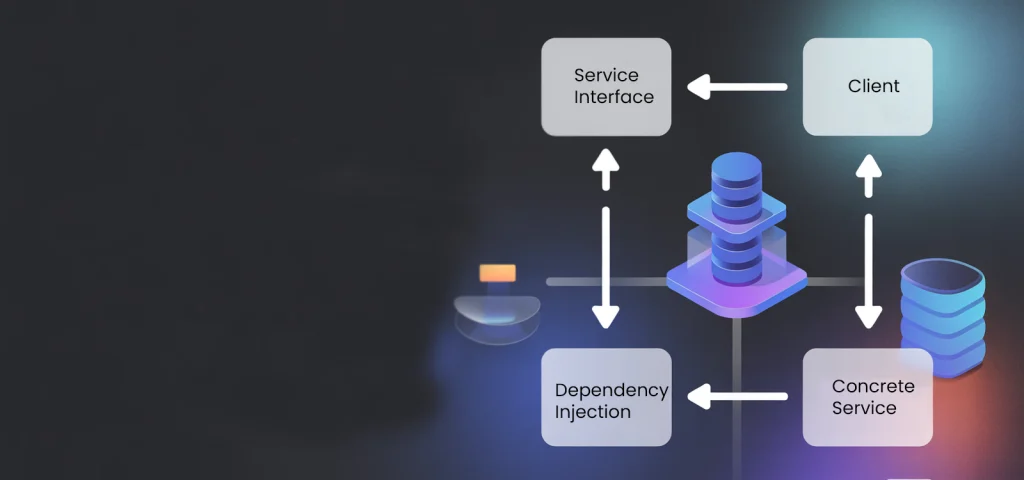

- Home
- Trending Technology
- What is Dependency Injection i ...
If you’ve been working in .NET for even a short time, you’ve likely heard about Dependency Injection i.e. DI. But do you truly understand how powerful it can be when done right?
At our core as a Dot Net Development Company, we believe in writing maintainable, testable, and clean code. Dependency Injection is one of the cornerstones that helps us maintain this approach. Whether you’re building enterprise software, a scalable web application, or a cloud-first solution, DI helps you reduce tight coupling and unlock flexibility in your codebase.
In this blog, we’ll walk you through what DI really means, break it down with real-world analogies, and show you why it’s essential for the .Net Revolution and the Future of Dot Net.
What is Dependency Injection
Dependency Injection is a design pattern used to implement IoC i.e. Inversion of Control.
DI allows the creation of dependent objects outside of a class; it also provides those objects to a class in different ways.
Here’s the simple way to look at it:
Instead of a class creating its own dependencies, those dependencies are “injected” into the class by some external source (often the framework).
Think of it like this:
You’re not baking a cake from scratch every time. You’re having a bakery deliver the exact cake you need – you just consume it when required.
Real-World Analogy
Let’s say you run a delivery service. Traditionally, you might write a DeliveryService class like this:
public void SendConfirmation()
{
public class DeliveryService
{
private readonly IMessageSender _messageSender;
public DeliveryService(IMessageSender messageSender)
{
_messageSender = messageSender;
}
public void SendConfirmation()
{
_messageSender.Send(“Order Confirmed.”);
}
}
You’ve decoupled the service. Now you can inject EmailSender, SmsSender, or even PushNotificationSender at runtime.
This is a principle we use daily in our Dot net development services – creating adaptable systems that evolve without rewriting core logic.
Why Dependency Injection Matters for Businesses?

As a Custom Dot Net Development Company, we’ve worked on dozens of codebases where lack of DI created a spaghetti mess of hard-coded dependencies, making the application hard to test, scale, or debug.
Here’s why DI is essential in modern and today’s real-world .NET applications:
Benefit | What It Means for Your Business |
Flexibility | Swap out modules without rewriting logic |
Testability | Inject mock services for unit testing |
Maintainability | Reduce repeated code and simplify updates |
Scalability | Easy to add new behaviors or services |
Types of Dependency Injection in .NET
.NET Core and .NET 5/6/7+ come with built-in DI support. Here are the three main types:
1: Constructor Injection (Most Common)
Dependencies are passed via the constructor.
public class OrderService
{
private readonly IPaymentGateway _paymentGateway;
public OrderService(IPaymentGateway paymentGateway)
{
_paymentGateway = paymentGateway;
}
}
2: Property Injection
3: Method Injection
DI in ASP .NET Core - Practical Example
Here’s how you can register and inject services using Microsoft’s built-in dependency container:
// In Startup.cs or Program.cs
services.AddScoped<IProductService, ProductService>();
services.AddSingleton<ILogger, ConsoleLogger>();
services.AddTransient<INotificationService, EmailNotificationService>();
Lifecycle Explanation:
Lifetime | Description | Use Case |
Singleton | Same instance for entire app | Logging, config, shared settings |
Scoped | One instance per request | Services that depend on user/session |
Transient | New instance every time | Lightweight, stateless services |
As your trusted Dot Net Development Company, we guide you in choosing the right lifetimes for your components to maximize efficiency and performance.
Real-World Project Application
Let’s say you’re building a fintech platform. You might have interfaces for:
- ITransactionService
- IAccountService
- INotificationService
- ILogger
Using DI, you can easily plug in different implementations depending on the environment (dev, staging, production), or even for different clients.
This is exactly how Virtual Coders as Your Dot Net Development Company structures modular, testable enterprise systems for global clients. Whether you’re integrating third-party APIs or scaling across regions, DI makes your architecture clean and adaptable.
Common Mistakes to Avoid
Even experienced developers make missteps when implementing DI. Here are a few we help our clients correct:
Mistake | What to do instead |
Injecting too many dependencies into a single class | Split logic across smaller services |
Registering services in the wrong lifecycle | Match service lifetime with usage |
Overusing static services | Prefer instance-based services for testability |
Using DI without interfaces | Always use abstractions to maintain flexibility |
These issues can slow down projects and lead to tech debt. That’s why many businesses turn to a Custom Dot Net Development Company like ours to get it right the first time.
Dependency Injection and the Future of .NET
As .NET continues to evolve, so does its approach to dependency management. DI is no longer optional; it’s foundational. From microservices to MAUI apps to Blazor components; DI powers today’s modern .NET architecture.
This is why DI plays such a huge role in the .Net Revolution. It’s setting the standard for scalable, testable, and maintainable development patterns across all layers of an application.
When you partner with a forward-thinking Dot Net Development Company like Virtual Coders, you’re not just adopting a pattern. You’re investing in the Future of Dot Net – and preparing your application for long-term growth.
Final Thoughts
Dependency Injection isn’t just a developer buzzword – it’s the backbone of scalable, maintainable .NET applications. From making your app easier to test to enabling seamless updates and integrations, DI delivers real-world business value.
At our firm, we’ve helped hundreds of companies implement DI across different industries – from finance and healthcare to SaaS and logistics. Virtual Coders as Your Dot Net Development Company – we understand how to bring clarity, flexibility, and performance into your .NET ecosystem.
Let’s Build Smarter with .NET
Ready to future-proof your application architecture?
Whether you’re starting from scratch or refactoring a legacy system, let us help. We offer industry-grade Dot net development services built on proven patterns like Dependency Injection.
- Hire Dot Net Developers that write clean, testable code.
- Hire Skilled Dot Net Developers to scale faster and smarter.
- Partner with a Custom Dot Net Development Company that gets it right from day one.
Get in touch with us today to learn how we can transform your .NET projects with expert guidance, smart architecture, and dependable delivery.
Adit Sheth
Adit Seth, CTO of Virtual Coders, is an accomplished engineer focused on software development and emerging technologies. His articles cover innovative coding practices and tech advancements, aiming to educate and inspire readers in the digital landscape.
Search
Recent Post
Why Offshore Engineering Teams Are the Future
- 1 week ago
- 7 min read
9 Ways Digital Transformation is Shaping Product
- 2 weeks ago
- 5 min read
Why .NET Remains the Top Choice for
- 3 weeks ago
- 6 min read







